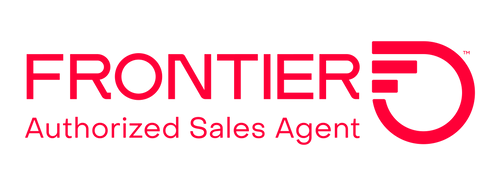When you’re stuck in the slow lane in traffic, it’s bad. But the slow lane on the Internet? Nope. The slow lane can cause movies to buffer (or crash) as soon as you’ve made the popcorn. Or cause a video call to glitch out—especially with someone you’re trying to impress. If you feel like you’re stuck or even just falling behind, you’re not alone. And chances are, you know someone who left the slow lane behind by switching to fiber. So, what is it, and how does fiber optic internet work?
So glad you asked…
Fiber optic internet is fast becoming one of the most popular ways to get online. Unlike traditional internet options that use copper cables to transmit electrical signals, fiber internet uses strands of glass or plastic to send data as pulses of light. This allows information to travel fast—near light-speed levels fast. And this results in faster downloads, smoother streaming, lower latency, and a more reliable connection. Which means you can watch your movie without buffering or attend online meetings without losing key parts of the conversation.
More communities, particularly in rural and underserved areas, are now gaining access to fiber thanks to local initiatives and infrastructure expansion. If you’ve recently received notifications that it’s in your area or you’re considering making the switch, you’re in the right place.
We’ll break down how does fiber optic internet work, the different types of fiber connections, and how to get it installed as well as how it stacks up against cable or DSL.
How Does Fiber Optic Internet Work?
Fiber optic internet feels like a modern luxury. So, you may be surprised to discover that the technology behind it has been in development for decades. In fact, fiber optics first emerged in the 1960s. By the 1980s, telecom companies were using it for long-distance phone networks. While originally developed for medical imaging and telecommunications, fiber has since evolved into one of the fastest, most reliable ways to access the internet.
So, how does fiber optic internet work to transmit data?
Instead of using electric signals like traditional copper cables, fiber transmits data as light pulses through ultra-thin strands of glass or plastic known as optical fibers. These fibers are thinner than a human hair. Yet when bundled together and protected by insulation, they create the powerful fiber-optic cables used today.
To break it down, your ISP sends data as beams of light using lasers or LEDs. That light then travels through the fiber cables (again, at nearly the speed of light), which is far, far faster than electrical signals. At your home, a device known as an Optical Network Terminal or ONT converts the light signals into the digital data your devices can understand.
Because light can travel long distances without degrading, fiber optic internet offers incredible speed, bandwidth, and stability. Even during peak usage times. It also supports symmetrical speeds. That means uploading large files or livestreaming is just as smooth as downloading your favorite shows.
The result: a proven technology that’s only getting better with time. As future-proof as tech can be.
Types of Fiber Internet
Not all fiber internet connections are equal. There are three main types of fiber setups:
- FTTH/FTTP (Fiber to the Home/Premises): The gold standard of fiber connections, this fiber runs directly to your home or business for the full benefits of fiber: near light-speed data, symmetrical upload and download speeds, and virtually no signal loss. Sweet! As one user shared, “I went from FNNT to FTTH, and honestly, it’s like night and day. No more 6 p.m. slowdowns. Gaming and dreaming are buttery smooth now.”
- FTTC (Fiber to the Curb or Cabinet): With FTTC, the fiber line goes to a cabinet or box near your home—usually within a few hundred feet. From there, the signal switches to traditional copper cables (e.g., phone lines) to complete the connection. It still offers better performance than DSL. However, it can also lead to some limitations in speed and reliability.
- FTTN (Fiber to the Node/Neighborhood): In this setup, fiber reaches a central hub in your neighborhood that can often be several blocks away. The remaining distance is covered by older infrastructure, which can significantly reduce performance, especially during peak usage times.
The biggest difference between the types is how close the fiber line gets to your home. The closer it gets, the faster and more consistent your service will be.
How to Get Fiber Internet Installed
Getting your fiber internet installed is typically a smooth process. As long as it’s available in your area. So first, you need to check availability. Fiber networks are expanding rapidly. But they’re still more common in urban and suburban areas. That said, rural communities are increasingly gaining access. Often, thanks to forward-thinking local government programs, electric cooperatives, and private-public partnerships.
Before you can get anything installed, you’ll want to search for service using your Zip code and specific address. If fiber isn’t available, don’t despair. Many providers allow you to pre-register your interest, which can help bring service to your area sooner. In my personal experience, while the area around us was being connected to fiber, it wasn’t until several neighbors and I went to the network provider in our community and asked for service that it expanded into our neighborhood. We were persistent. And our neighborhood went from “unlikely” to fully served. Best of all, not only was it light years faster, but it was also at a reduced cost compared to the service previously available. It took some time, but we couldn’t be happier.
If fiber is available, the next step is to schedule installation. This often involves running a fiber line from the street or nearest node and installing an ONT on the outside or inside of your home. Finally, you’ll connect your router to the ONT and have in-home Wi-Fi.
In newer neighborhoods, the fiber lines may already be installed underground, making the process even easier.
Fiber vs. DSL vs. Cable: What’s the Difference?
Considering fiber but first want to know how well it compares with other types of internet service, such as DSL or cable?
In short, fiber is faster, more reliable, and often the best long-term investment. Here’s a quick comparison:
Fiber
Speed: Up to 1 Gbps + (symmetrical)
Uploads: Equal to download (fast)
Latency: Very low
Reliability: Excellent (and not affected by weather or distance)
Availability: Expanding, especially in new housing and due to rural broadband initiatives
Ideal for: Streaming, remote work, smart homes, and gaming
Cable
Speed: Up to 1 Gbps (asymmetrical)
Uploads: Much slower than download
Latency: Moderate
Reliability: Can slow during peak times
Availability: Widely available
Ideal for: Streaming, browsing, and light gaming
DSL
Speed: 5 – 100 Mbps
Uploads: Slow
Latency: High
Reliability: Can degrade with distance from provider
Availability: Common in older infrastructure areas
Ideal for: Basic browsing, email, and light use
In other words, fiber doesn’t just beat DSL, it also outperforms cable most of the time. Uploading large files? Hosting video meetings? Watch parties? Gaming online? Fiber keeps it smooth! Plus, it’s the most future-ready option.
“Cable was okay until my neighbors started streaming 4K everything. Switched to fiber, and no matter the time of day, it’s solid. Didn’t realize how much lag I had been dealing with until it was gone,” shares one user.
Is Fiber Internet Right for You?
How does fiber optic internet work? In a word: brilliantly.
By transmitting data as pulses of light through glass strands, it delivers lightning-fast, highly reliable, and often surprisingly affordable internet. Internet built not just for today’s demands, but for tomorrow’s as well.
And every year, it’s becoming more accessible. And real users are loving the difference: “I admit, I didn’t think I’d see much difference. But switching to fiber was like upgrading from a flip phone to a smartphone. Everything just works better.”
Ready to leave buffering and lag behind? Who isn’t?! Check to see if it’s available (or will be soon) in your area, explore your options, and take a big step toward a faster, more reliable internet connection.











